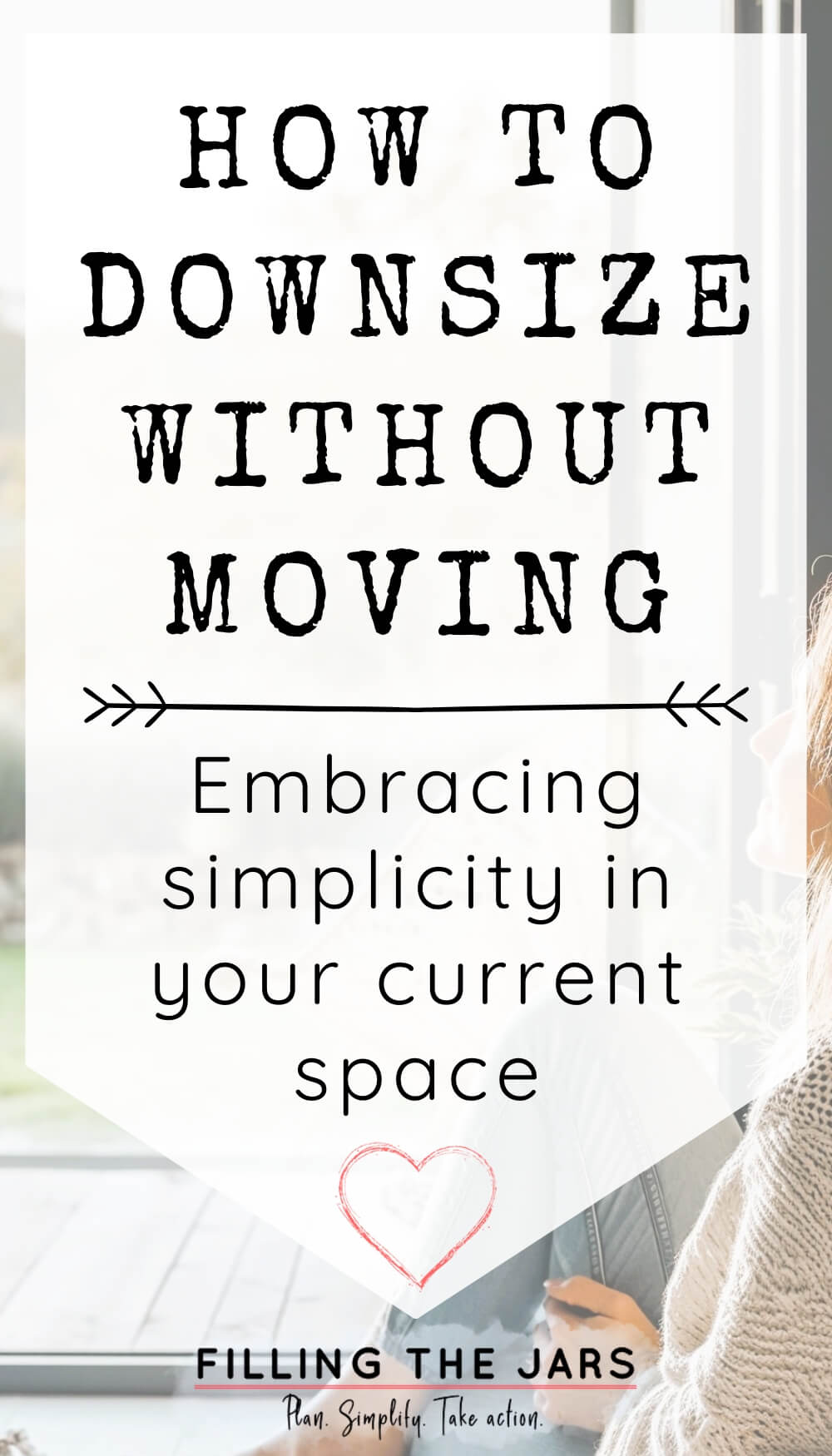Thinking of downsizing but dread the thought of moving? I hear you! Many folks wish for a simpler life with less clutter but can’t face the upheaval of a move. Lets talk about ‘dowsizing in place’ — or, how to downsize without moving.
You can think of it as a practice run for when you decide to take the leap to fully downsizing. These can be your first steps. Or, you may find that this is the perfect solution for you to age in place for many years to come.
Here’s the thing though… aside from the logistics of finding a new home and moving your possessions, downsizing without moving can actually be a more difficult option. It’s definitely still worth the effort, so let’s talk about the challenges, the how-tos, and the benefits of downsizing in place…

This post may contain affiliate links. If you choose to purchase through an affiliate link, I may receive a small commission at no additional cost to you. You can see my full disclaimer here.
There’s a lot to consider when you decide to downsize, even if you aren’t physically moving locations.
This blog post will cover:
- What to consider during your downsizing decision-making process
- Suggestions for positive ways to think about and approach downsizing in place
- Essential strategies for decluttering
- Ideas to figure out which of your belongings are earning their space
First, let’s talk about some of the benefits of downsizing your current space…
Why Downsize Without Moving?
So why would you want to downsize your life without moving?
Perhaps you love your neighborhood and don’t want to leave, or you want to stay close to family and friends. Maybe you’ve already paid off your mortgage and don’t want to take on a new one. Whatever your reasons, downsizing in place can be a smart choice that allows you to enjoy the benefits of less stuff without having to go through the hassle of moving.
But in the end, it’s usually about craving a simpler, more manageable lifestyle.
Benefits of Downsizing in Place
- Qualify of Life: Living in a decluttered, well-organized space can significantly reduce stress levels, leading to better overall mental health. You may also notice an improvement in everyday living with smoother daily routines.
- Physical Comfort: With less clutter, your home becomes safer and more comfortable. This is especially beneficial for mobility and creating a more accessible living environment.
- Financial Savings: While not moving to a smaller home, downsizing within your current space can still lead to financial benefits. Fewer belongings can mean lower expenses on things like maintenance, cleaning supplies, and utility costs due to more efficient space usage. For some people, remaining in their current home can mean considerable annual property tax savings (although that can vary depending on your individual situation).
- Increased Leisure Time: Maintaining all.the.things can be a huge time-suck. With less time required for cleaning and organizing, you gain more time for hobbies, relaxation, and spending quality time with family and friends.
- Preparing for Future Changes: Even if you’re not moving now, downsizing can be a proactive step towards a future move, making any eventual transition easier and more manageable.
By truly internalizing the desire for these benefits, you can see downsizing in place not as a sacrifice, but as a positive, rewarding process that enhances many aspects of life. When you’re ready to simplify your life, this is part of the path to more intentional living.
How to Start Downsizing
When downsizing in place, there are many things to consider beyond just decluttering. You’ll need to think about your vehicles, financial situation, and other aspects of your life that may be impacted by downsizing. It’s important to weigh the pros and cons of downsizing in place versus moving to a smaller home to determine which option is best for you. By taking the time to carefully consider all of your options, you can make an informed decision that will help you achieve your goals and live the life you want.
1. Get REALLY clear on WHY you want to downsize. Some common reasons: saving money, better accessibility, simplify maintenance and cleaning. (You’ll probably have even more unique reasons.)
2. Rethink every.single.thing. you use. This includes things like vehicles, clothing, furniture, kitchen stuff, recreational gear, whether or not you use all of the spaces in your home. (Can/should you shut some rooms to save on heating/cooling?)
3 Talk to your tax planner or financial planner regarding the potential tax implications of downsizing in place vs. moving.
Downsizing ‘Non-Clutter’ Aspects of Your Life

When downsizing, it’s not just your in-home physical possessions that need to be considered. Several other things also need to be evaluated and managed. Here are a few things to keep in mind:
Review Financial Commitments
One of the biggest benefits of downsizing is the potential for significant cost savings. However, it’s important to take a close look at your financial commitments to ensure you’re making the most of your downsizing efforts. This includes evaluating your mortgage or rent payments, utility bills, and any other recurring expenses you may have.
One of the biggest factors to consider when deciding whether to downsize in place or move to a smaller home is cost. Downsizing in place can be a more cost-effective option since you won’t have to pay for the costs associated with moving, such as hiring movers, buying new furniture, and paying for closing costs. However, downsizing in place may require you to make modifications to your current home, such as installing grab bars or widening doorways, which can be expensive.
As you’re downsizing your financial life, you’ll want to look at every expense, including memberships or subscriptions that you no longer make full use of.
Evaluate Vehicle Ownership
Owning a car can be expensive, especially if you’re no longer commuting to work or driving long distances. Downsizing can be a great opportunity to reduce your vehicle ownership and save money on car payments, insurance, and maintenance.
Consider selling one or more of your vehicles and using public transportation, car-sharing services, or biking and walking instead. You may also want to consider downsizing to a more fuel-efficient vehicle that is cheaper to operate and maintain.
Manage Your Digital Footprint
In today’s digital age, downsizing also means managing your digital footprint. This includes reducing your online presence and minimizing your digital clutter.
Consider deleting old email accounts, unsubscribing from unnecessary newsletters and mailing lists, and deleting or storing old files and photos. You may also want to consider deleting your social media accounts and minimizing your online activity to reduce your digital footprint and protect your privacy.
Setting a Realistic Approach to Downsizing Without Moving

When it comes to the big part of downsizing in place — decluttering — you’ll need a strategy and focus, so let’s get to some ideas to help you with the process.
I often say, ‘The best way to downsize is to declutter like you’re moving.’
Which sounds great in theory. But… sometimes it’s harder than actually moving because when you’re not going anywhere, your brain is MUCH more insistent about keeping all.the.things.
Flipping that switch in your mind to having a decluttering mindset is the biggest part of the process.
Along with mindset, successfully downsizing in your current home requires setting achievable objectives and following a strategic approach. This helps you make meaningful progress without feeling overwhelmed.
Achievable Objectives for Downsizing and Decluttering
You don’t need to do all of these at the same time. Try them, see what works for you, and then keep using those ideas.
Keep in mind your WHY: You decided to downsize your stuff for a reason, and you need to always remember that reason. I promise this will make clearing clutter so much easier!
If you get into the process and your thinking starts to feel negative, take time every day to work through some of those feelings and build positive thoughts.
Set simple targets: Set specific, measurable goals like decluttering a certain number of items each day. My magic number is 10 → that’s 10 items per day and/or 10 minutes of decluttering work per day.
I call it slow decluttering — but you’ll actually be amazed at how quickly you see big changes.
Room-by-room goals: Create clear objectives for each room. For example, aim to simplify the kitchen in one week, followed by downsizing the living room in the next.
Related: 25 Things To Declutter In The Kitchen (And 3 Unexpected Items To Keep)
Time-based goals: Assign realistic timeframes for each goal. For instance, decide to declutter the garage within a month or organize your wardrobe over a week.
Sequential focus: Tackle your downsizing project one room or category at a time. Start with your easier areas to build momentum and confidence. In other words, decluttering sentimental items needs to wait!
Weekly check-ins: Set aside time each week to review your progress and adjust your goals and strategies as needed. Grab the printable quick-start mini declutter plan and be sure to use the tracking page!
Strategies for Effective Decluttering In Place
Knowing what to expect and building a strategy that works for you helps keep you focused so you can finish the process in the timeframe that you’ve set.
Anticipate all the feelings: Sorting and decluttering a lifetime of belongings will take time and patience. You’re going to run across items that bring up surprising amounts of memories and unexpected feelings, even if you begin with ‘easier’ areas.
Don’t give up if you feel overwhelmed. Allow yourself time to ‘feel the feels’ and work through them.
For sentimental items that are hard to let go of, use an ‘Emotional Item Box’. Place these items in the box and revisit them after a few months to decide if you’re ready to part with them. Be cautious here… don’t develop the habit of putting everything in the box.
Set clear decluttering ground rules: When decluttering, always stick to clear ground rules.
Categorize Items: As you assess your belongings, categorize them into ‘Keep’, ‘Donate’, and ‘Discard’. This method simplifies decision-making and keeps the process organized.
Some of my personal rules, which you can use if they work for you:
- Donate everything instead of trying to sell it or find the ‘perfect’ recipient.
- Apply the ‘One-Year Rule’ — if an item hasn’t been used in the last year, it’s likely time to donate or discard it. This helps in making objective decisions about rarely used items.
- Get the decluttered items out of your home immediately.
- Remember that YOU make the decisions, and don’t let yourself make exceptions.
I have more thoughts on rules for decluttering. Feel free to hop over and read them if you need more inspiration.
Start immediately and pace yourself: Don’t try to declutter everything at once.
If you’ve been in your home for many years, you’ve probably got a lot of stuff. That means there’s a big job in front of you, and you want to be able to finish it without giving yourself anxiety over decision-making. (You’ll get better at making decisions as you declutter more and more.)
Related: Decluttering After 50: Tips For Dealing With A Lifetime of Stuff
Deal with other people’s stuff first: You are not the Keeper Of The Things.
If you’re storing belongings for your children, family, or friends, it’s time for a change. Contact them to see when they would like to pick up their stuff.
If they don’t commit, be very clear about when and how you will discard their things. Remind yourself that you are not responsible for anyone’s belongings other than your own. If they refuse to take responsibility, then it’s absolutely okay to donate or trash those things without even sorting them. Be strong.
Seeking Support and Assistance
Downsizing can be a challenging process, both physically and emotionally. Don’t be afraid to seek support and assistance from friends, family, or professionals. Consider hiring a professional organizer or downsizing specialist to help you with the process. Additionally, you may want to talk to a therapist or counselor if you’re feeling overwhelmed or anxious about the process.
By creating a timeline, setting achievable objectives, and seeking support and assistance, you can successfully implement your downsizing plan and enjoy the benefits of a simpler, more streamlined lifestyle.
Deciding What To Keep When Downsizing

The pressure to keep all.the.RIGHT.things feels pretty intense. Here’s the thing… nobody ever keeps exactly the right things.
So take some of that pressure off and let’s think about this downsizing decluttering process as a GOOD thing — no matter what your age or circumstances. Do your best when deciding what to keep, but don’t agonize over trying to make the perfect decision every time.
- Decide which items are earning their space in your life (far fewer than you think!). Evaluate each item for how much energy it costs you (in time, space, money, physical labor) to store, maintain, and/or use it.
Here are some tips for what to keep when downsizing:
- Keep sentimental items that are truly special to you (focus on what you really love and read these tips for decluttering sentimental items).
- Keep furniture and other items that are valuable or hard to replace AND that you love! Otherwise, sell the really valuable items or give them away to someone else who wants them and will love them. But don’t get hung up on finding perfect homes for everything! You probably already know who wants your stuff.
- Keep items that you use regularly.
- Get rid of everything else!
Reimagining Your Space
As you downsize your belongings, you’ll want to reimagine your living space to align with your new, simplified lifestyle. This involves strategic rearranging of furniture and adopting more minimalist design principles to maximize both functionality and aesthetic appeal.
Rearranging for Lifestyle Maximization
- Creating Open Pathways: Arrange your furniture to create clear, open pathways. This not only makes your space more navigable but also contributes to a feeling of openness and flow.
- Multifunctional Areas: Designate areas in your home for multiple uses. For instance, a dining table can double as a workspace, or a guest room can be arranged to also serve as a home office or hobby room. This maximizes the utility of every area in your home.
- Zone Creation: Create distinct zones for different activities, even within the same room. Use furniture arrangement to subtly divide spaces.
- Minimizing Furniture Footprint: Choose furniture that occupies less physical space or has a minimalist design. For instance, opt for a sleek sofa or chairs with slender frames, which can make the room appear larger.
Minimalist Design Principles
Consider these if you’re ready to downsize your decorating style for something more functional and minimalist, but still beautiful and stylish.
- Quality Over Quantity: In line with minimalist philosophy, select fewer pieces of furniture and decor, but focus on the quality and functionality of each item. This reduces visual clutter and emphasizes the beauty of each piece.
- Decluttered Surfaces: Keep surfaces like countertops, tables, and shelves mostly clear. This not only adds to the minimalist aesthetic but also creates a more peaceful and organized environment.
- Smart Lighting: Use lighting to enhance the sense of space. A combination of natural light, accent lighting, and task lighting can make a room feel more welcoming.
- Textural Elements: Introduce texture through fabrics and materials to add depth and interest without clutter. For instance, a textured rug or throw pillows can add warmth and comfort to a minimalist space. Just remember to be mindful of your mobility and maintenance objectives.
By reimagining your space with these strategies, you can transform your home into a functional, aesthetically pleasing environment that reflects your downsized lifestyle.
Even if ‘minimalism’ isn’t your style, you’ll want to carefully evaluate EVERY room’s furniture and accessories to be sure they support your daily activities, mobility, and well-being.
Tips for Long-Term Success

Maintaining the benefits of your downsized space requires ongoing effort and adaptability. Here are some key strategies to ensure long-term success in your downsized, simplified home environment.
Maintaining a Decluttered Space
- Daily ’10-Minute Tidy’ Routine: Incorporate a brief, daily routine. Allocate 10 minutes each day to quickly tidy up, put things back in their place, and handle any small clutter that has accumulated. This prevents clutter from building up and keeps your space consistently neat.
- One-In, One-Out Rule: For every new item you bring into your home, ensure an existing item is removed. This policy helps maintain the balance of items in your home and prevents re-cluttering.
- Regular Decluttering Sessions: Schedule regular, more thorough decluttering sessions (e.g., monthly or seasonally). This is an opportunity to reassess items and decide if anything else can be discarded, donated, or stored differently.
- Visible Reminders: Keep visual reminders of your downsizing goals and achievements. This could be before-and-after photos of decluttered spaces, a decluttering checklist on your fridge, or motivational quotes that encourage a minimalist lifestyle.
Adapting to Changes
- Periodic Reassessment of Space: Every few months, take time to reassess how each area of your home is functioning. As your needs and lifestyle change, your space should evolve too. For instance, a spare room might need to transform from a home office to a workout space or a play area for grandchildren.
- Flexibility in Arrangement: Be open to changing the arrangement and purpose of your rooms and furniture. The layout that worked initially might need adjustment as you settle into your downsized lifestyle.
- Embracing Change as Opportunity: View changes in your life and household as opportunities to reassess your possessions and layout. Each change is a chance to further optimize and enjoy your living space.
By following these tips, you can not only sustain the benefits of your downsized home but also continuously enhance and adapt your living space to suit your evolving needs. The key is in a mindful approach to possessions and an adaptable mindset towards your living environment.
More Decluttering Help And Inspiration
How to Declutter Your Wardrobe {and Still Have Plenty to Wear}
10 Takeaways From Swedish Death Cleaning That Will Inspire You To Declutter
20 Game-Changing Decluttering Hacks That Actually Work
Downsizing within your current home is a rewarding journey toward simplicity and intentionality. Embrace this process of decluttering and reimagining your home, and enjoy the peace and clarity that comes with a downsized lifestyle.
You’ve got this!
Did you enjoy this post? Know someone else who might like it? Please take a moment to share on Pinterest, Facebook, or your favorite social media… (Click the sharing buttons at the bottom of the post.) Thank you!



We are slimming down, cleaning out the empty nest. Like your tips.